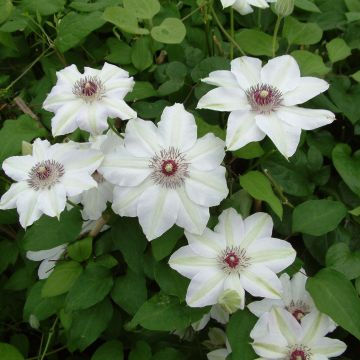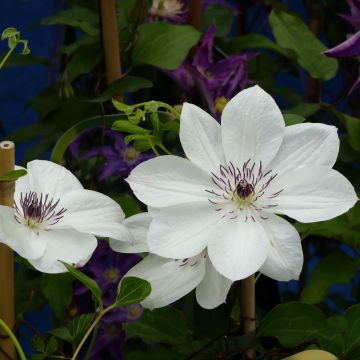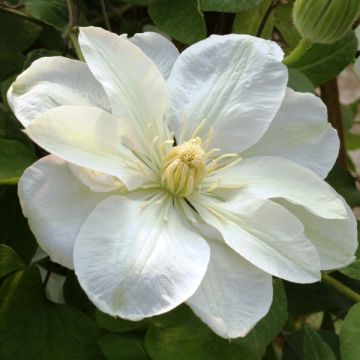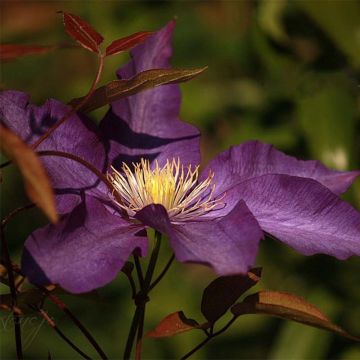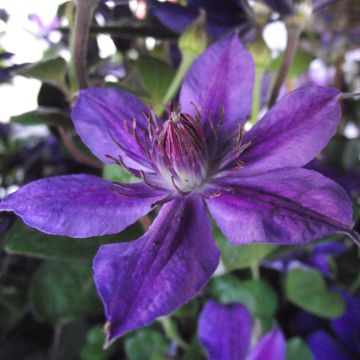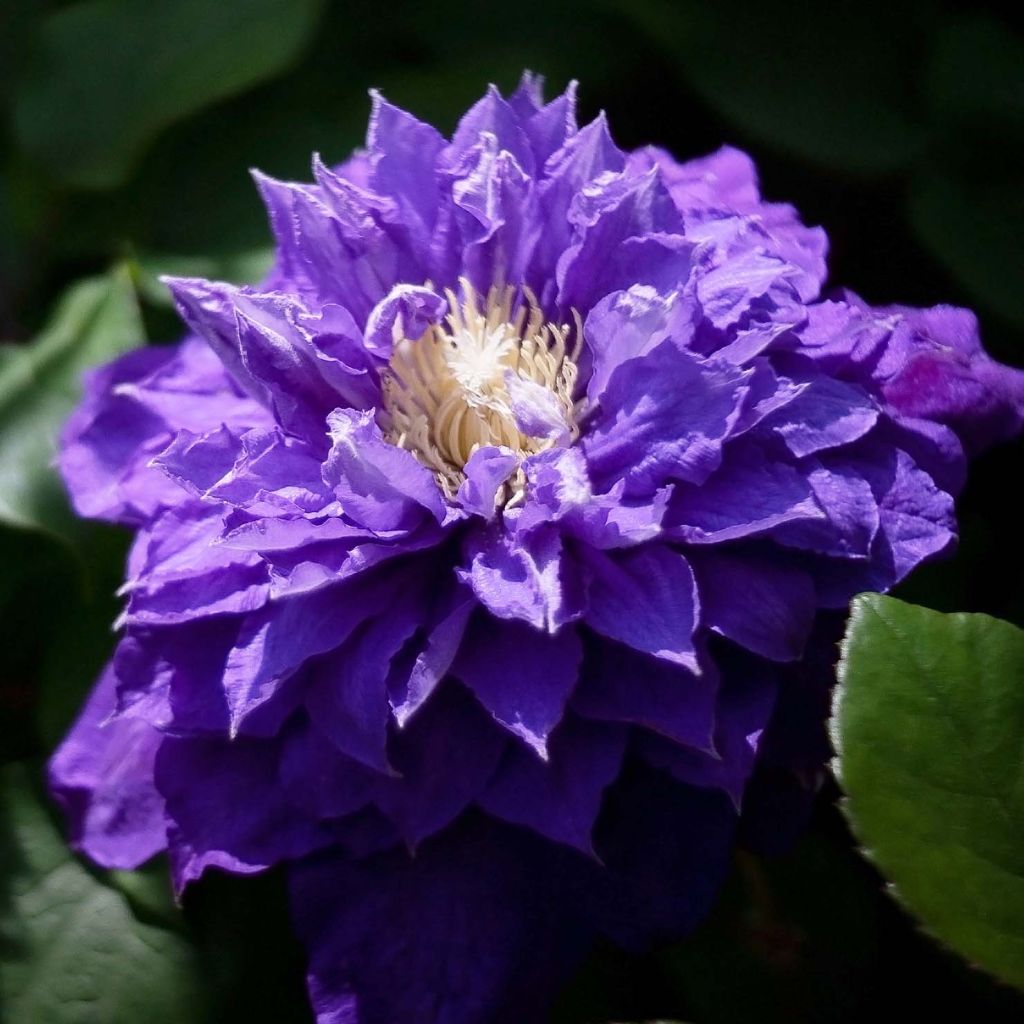

Clematis Beauty of Worcester
Clematis Beauty of Worcester
Clematis Beauty of Worcester
Old Man's Beard, Traveller's Joy, Virgin's Bower, Leather Flower
This item cannot be shipped to the selected country
Delivery charge from €5.90
More information
Schedule delivery date,
and select date in basket
This plant carries a 6 months recovery warranty
More information
We guarantee the quality of our plants for a full growing cycle, and will replace at our expense any plant that fails to recover under normal climatic and planting conditions.
From €5.90 for pickup delivery and €6.90 for home delivery
Express home delivery from €8.90.
Does this plant fit my garden?
Set up your Plantfit profile →
Description
The Clematis Beauty Of Worcester is a truly graceful old variety of clematis, which always captivates with its vigor and the beauty of its large flowers. They are a fairly bright blue-violet with a hint of pink, enhanced by cream stamens. In late spring, they are filled with undulating petals, while those that appear in late summer are single and star-shaped. With its moderate growth, this small climbing plant is very suitable for small gardens and container cultivation.
Clematis belong to the renonculaceae family. The 'Beauty of Worcester' variety was obtained in 1886 in England. It is one of the two parents of the famous clematis 'Vyvyan Pennell'. It is a perfectly perennial and hardy plant, semi-woody and climbing, which will reach about 2.25m (7ft) to 2.50m (8ft) in height, with a minimum spread of 1m (3ft). The plant develops new shoots in spring, from buds located on the mature stems. Each stem produces a floral bud that blooms in May-June. A new flowering occurs on the young stems in August-September. This variety bears compound flowers with lanceolate-shaped tepals, quite narrow, resembling leaves, about 12.5cm (5in) wide, sometimes 15cm (6in). They are upright and have a lovely cluster of very pale yellow stamens in their center, contrasting with the blue-violet color of the tepals. The flowering is followed by decorative feathery silver-gray fruits that persist until winter. The deciduous leaves are divided into 3 or more leaflets, of a fairly deep green. This clematis clings to the support or host plant on its own through petioles transformed into tendrils.
Plant your clematis alongside your climbing roses or lianas to extend the flowering of your walls and pergolas until the end of summer. Place pretty perennials such as geraniums, carnations, sage nemorosa, and phlox at their base, which will provide the shade they appreciate. It is a genus rich in diversity, with varieties available in all colours, shapes, and sizes. Take advantage of their ease of cultivation to give your garden a romantic and bohemian touch. 'Beauty of Worcester' loves to weave itself into bushes and performs very well in a large pot. It will work wonders in a beautiful jar on the terrace, in the garden among the border plants, or even on a small fence.
Report an error about the product description
Clematis Beauty of Worcester in pictures
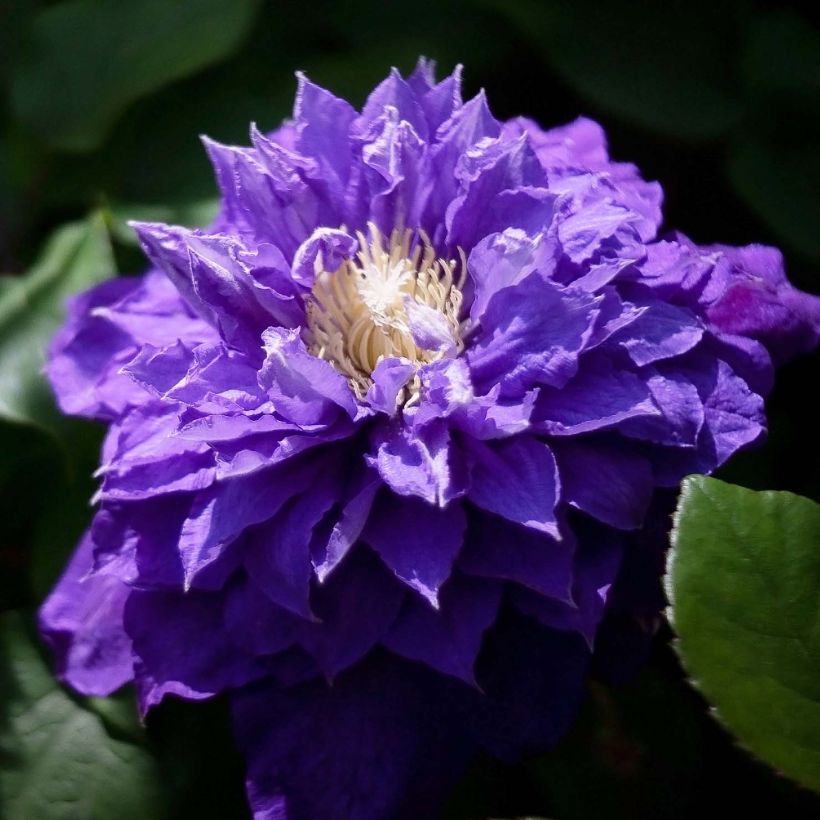

Plant habit
Flowering
Foliage
Botanical data
Clematis
Beauty of Worcester
Ranunculaceae
Old Man's Beard, Traveller's Joy, Virgin's Bower, Leather Flower
Cultivar or hybrid
Other Clematis Patens
Planting and care
The Clematis 'Beauty Of Worcester' will appreciate a sunny or lightly shaded position near a tree. Plant it in fertile, humus-rich soil, preferably well-drained, shading the roots and base of the stem (with a flat tile, for example). It tolerates limestone well. Clematis should be planted at an angle, with the root ball almost horizontal and oriented towards its support. Install it by covering the root ball with 3 cm (1in) of soil, in soil worked to a depth of 20 cm (8in), lightened with good compost and coarse sand. After planting, prune the Clematis stems to about 30 cm (12in) above a nice pair of buds. In the first few weeks, water regularly. However, be careful not to let the water stagnate as this can cause fungus to develop at the collar. Mulch all Clematis plants in February with garden compost or well-rotted manure, avoiding direct contact with the stems. Train the stems, without squeezing them, until the plant can grip itself. Clematis also like to grow freely on neighboring plants. Prune after the first flowering, in June-July, to 75 cm (0 to 30in) above the ground, above a pair of nice buds.
After a few years, cover the base of your climbing Clematis with a small mound of soil, this will reduce the risk of wilting while promoting the growth of vigorous shoots from the stump. Voles and grey worms can attack Clematis and devour the stems. Aphids and greenhouse whiteflies are also potential parasites of Clematis.
Planting period
Intended location
Care
-
, onOrder confirmed
Reply from on Promesse de fleurs
Clematis
Haven't found what you were looking for?
Hardiness is the lowest winter temperature a plant can endure without suffering serious damage or even dying. However, hardiness is affected by location (a sheltered area, such as a patio), protection (winter cover) and soil type (hardiness is improved by well-drained soil).

Photo Sharing Terms & Conditions
In order to encourage gardeners to interact and share their experiences, Promesse de fleurs offers various media enabling content to be uploaded onto its Site - in particular via the ‘Photo sharing’ module.
The User agrees to refrain from:
- Posting any content that is illegal, prejudicial, insulting, racist, inciteful to hatred, revisionist, contrary to public decency, that infringes on privacy or on the privacy rights of third parties, in particular the publicity rights of persons and goods, intellectual property rights, or the right to privacy.
- Submitting content on behalf of a third party;
- Impersonate the identity of a third party and/or publish any personal information about a third party;
In general, the User undertakes to refrain from any unethical behaviour.
All Content (in particular text, comments, files, images, photos, videos, creative works, etc.), which may be subject to property or intellectual property rights, image or other private rights, shall remain the property of the User, subject to the limited rights granted by the terms of the licence granted by Promesse de fleurs as stated below. Users are at liberty to publish or not to publish such Content on the Site, notably via the ‘Photo Sharing’ facility, and accept that this Content shall be made public and freely accessible, notably on the Internet.
Users further acknowledge, undertake to have ,and guarantee that they hold all necessary rights and permissions to publish such material on the Site, in particular with regard to the legislation in force pertaining to any privacy, property, intellectual property, image, or contractual rights, or rights of any other nature. By publishing such Content on the Site, Users acknowledge accepting full liability as publishers of the Content within the meaning of the law, and grant Promesse de fleurs, free of charge, an inclusive, worldwide licence for the said Content for the entire duration of its publication, including all reproduction, representation, up/downloading, displaying, performing, transmission, and storage rights.
Users also grant permission for their name to be linked to the Content and accept that this link may not always be made available.
By engaging in posting material, Users consent to their Content becoming automatically accessible on the Internet, in particular on other sites and/or blogs and/or web pages of the Promesse de fleurs site, including in particular social pages and the Promesse de fleurs catalogue.
Users may secure the removal of entrusted content free of charge by issuing a simple request via our contact form.
The flowering period indicated on our website applies to countries and regions located in USDA zone 8 (France, the United Kingdom, Ireland, the Netherlands, etc.)
It will vary according to where you live:
- In zones 9 to 10 (Italy, Spain, Greece, etc.), flowering will occur about 2 to 4 weeks earlier.
- In zones 6 to 7 (Germany, Poland, Slovenia, and lower mountainous regions), flowering will be delayed by 2 to 3 weeks.
- In zone 5 (Central Europe, Scandinavia), blooming will be delayed by 3 to 5 weeks.
In temperate climates, pruning of spring-flowering shrubs (forsythia, spireas, etc.) should be done just after flowering.
Pruning of summer-flowering shrubs (Indian Lilac, Perovskia, etc.) can be done in winter or spring.
In cold regions as well as with frost-sensitive plants, avoid pruning too early when severe frosts may still occur.
The planting period indicated on our website applies to countries and regions located in USDA zone 8 (France, United Kingdom, Ireland, Netherlands).
It will vary according to where you live:
- In Mediterranean zones (Marseille, Madrid, Milan, etc.), autumn and winter are the best planting periods.
- In continental zones (Strasbourg, Munich, Vienna, etc.), delay planting by 2 to 3 weeks in spring and bring it forward by 2 to 4 weeks in autumn.
- In mountainous regions (the Alps, Pyrenees, Carpathians, etc.), it is best to plant in late spring (May-June) or late summer (August-September).
The harvesting period indicated on our website applies to countries and regions in USDA zone 8 (France, England, Ireland, the Netherlands).
In colder areas (Scandinavia, Poland, Austria...) fruit and vegetable harvests are likely to be delayed by 3-4 weeks.
In warmer areas (Italy, Spain, Greece, etc.), harvesting will probably take place earlier, depending on weather conditions.
The sowing periods indicated on our website apply to countries and regions within USDA Zone 8 (France, UK, Ireland, Netherlands).
In colder areas (Scandinavia, Poland, Austria...), delay any outdoor sowing by 3-4 weeks, or sow under glass.
In warmer climes (Italy, Spain, Greece, etc.), bring outdoor sowing forward by a few weeks.



































